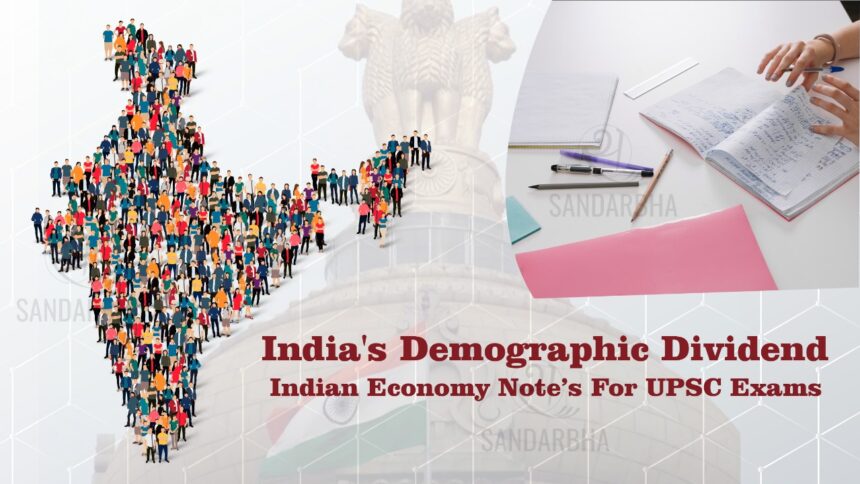The term “Demographic Dividend” encapsulates the potential for economic growth within a country, driven by shifts in its population’s age structure. Coined by David Bloom, this concept hinges on fluctuations in fertility and mortality rates, which shape the demographic landscape of nations. Essentially, it refers to the advantageous scenario where a country’s active population (aged 15 to 64) surpasses its dependent population (comprising those 14 and younger, and 65 and older). Countries experiencing the demographic dividend witness accelerated economic growth due to declining fertility and mortality rates. This phenomenon holds immense significance and is an integral part of the UPSC syllabus, necessitating comprehensive understanding for aspirants preparing for the exam.
Deciphering India’s Demographic Dividend: Analyzing Key Factors and Warren Thompson’s Model
The Demographic Dividend hinges on several factors, including shifts in population structure, decreasing birth rates, increased life expectancy, and sustained drops in fertility rates. Warren Thompson’s Demographic Transition Model outlines four stages of demographic evolution: pre-industrial, urbanization and industrialization, mature industrial, and post-industrial phases. In the context of India, the demographic dividend looms prominently. India boasts the highest ratio of youth to other age groups globally, with a median age of just 28 years as of 2020, compared to 37 in China and the USA, and significantly higher figures in Western Europe and Japan. India’s working-age population (15 to 64 years) is on a sharp incline relative to its dependent population, attributed to improved standards of living and a marked decrease in total fertility rates.Browsing Through India’s Demographic Dividend: Insights from the United Nations Population Fund
The United Nations Population Fund underscores two noteworthy aspects regarding India’s demographic dividend: Firstly, India possesses an extended window of opportunity spanning five decades, from 2005-06 to 2055-56, surpassing other countries globally. Secondly, the demographic dividend’s potential varies across states due to diverse population parameters. Recent updates highlight India’s status as the world’s youngest population, with a median age of 28.4 years as of 2022. Notably, the total fertility rate plays a pivotal role in augmenting India’s working-age populace. While the total fertility rate has halved since 1990, substantial disparities exist among states, with Delhi, Maharashtra, and Tamil Nadu exhibiting lower rates compared to Bihar, Madhya Pradesh, and Uttar Pradesh.Strategies and Imperatives for India’s Demographic Dividend
Initiatives such as Atmanirbhar Bharat, Make in India, and Startup India aim to harness India’s demographic potential. The demographic dividend presents numerous opportunities for India:- Strengthening the workforce and enhancing economic growth.
- Increasing personal earnings and purchasing power.
- Empowering women, reducing fertility rates, and stimulating economic growth.
- Facilitating social mobility, particularly among low-income groups.
- Boosting productivity in sectors like manufacturing.
Measures to capitalize on the demographic dividend
Historically, the demographic dividend has contributed up to 15% of total growth in advanced economies. Japan serves as a prime example, experiencing rapid growth between 1964 and 2004 owing to demographic shifts. To capitalize on India’s demographic dividend, strategic measures are imperative:- – Enhancing investment in education and literacy.
- – Improving healthcare infrastructure.
- – Promoting research and development.
- – Fostering skill development initiatives.
Challenges associated
However, India faces several challenges in maximizing its demographic dividend:- – Skill deficiencies and unemployment among the working-age population.
- – Persistent disparities in health, education, and living standards.
- – Dominance of the agricultural sector and informal employment.
- – Gender inequality and limited female workforce participation.
- – Low job creation rates and inadequate social security measures.
How to fulfill the demographic dividend?
To unlock India’s demographic dividend, concerted efforts are required:- – Enhancing the education system to nurture talent.
- – Prioritizing skill development through initiatives like NSDC.
- – Ensuring universal healthcare access through schemes like Aayushman Bharat.
- – Fostering job creation through entrepreneurial ventures and industrial growth.











